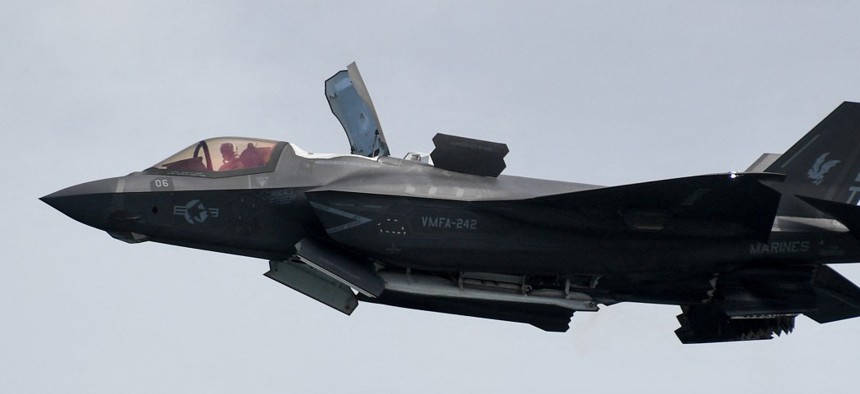Lawmakers ask why DOD isn’t sharing ‘public’ weapons systems Info

A US Marine Corps F-35B Lightning II, a short takeoff and vertical landing (STOVL) version of the Joint Strike Fighter aircraft, flies past during a preview of the Singapore Airshow in Singapore on February 13, 2022. ROSLAN RAHMAN/AFP via Getty Images
They pointed to a “break from historical precedent.”
A group of lawmakers raised concerns this week that the Pentagon is being too tight-lipped with what should be public information about taxpayer-funded military weapons.
In a 4-page letter penned to Defense Secretary Lloyd Austin on Wednesday, House Oversight and Reform Committee Chair Carolyn Maloney, D-N.Y., and National Security Subcommittee Chair Stephen Lynch, D-Mass., as well as Government Operations Subcommittee Chair Gerry Connolly, D-Va., and Vice-Chair Katie Porter, D-Calif., detailed how the department “inappropriately limited access to information related to military weapon systems” by marking it as controlled unclassified information, or CUI.
“As DOD works to protect sensitive details about U.S. military weapon systems, the department must strike a balance to ensure that sensitive information is handled appropriately, while information in the public interest is not kept secret,” they wrote. “Increased secrecy will result in less transparency and accountability regarding the efficacy of these systems.”
Each year, the DOD’s Operational Test and Evaluation director publishes an annual report that includes assessments of major weapons systems’ performance and viability. The DOT&E has previously produced these reports in an unclassified format, disseminated in a way that is accessible to the public.
“However, in a break from historical precedent,” the annual report for fiscal 2021 and released in January 2022, “includes both a public and CUI version,” the lawmakers wrote. A former acting director said the information had to be guarded so it wouldn’t “‘end up in our adversaries’ hands,’” but the lawmakers argued that such a concern has been applied “too broadly.”
“As a result, information on military weapon systems that was previously available to the public is now marked CUI in multiple instances, hiding it from the view of U.S. taxpayers,” they wrote.
Among multiple examples of this listed, the lawmakers pointed out that the unclassified version of the latest report excludes a range of information on the F-35 Joint Strike Fighter—what they call the “most expensive weapons acquisition system program in the history” of DOD—that was incorporated in previous reviews. Specific details about the hardware and software deficiencies associated with the system are omitted from the latest report, for instance.
“We request that DOD and its components review the information regarding military weapon systems that is marked CUI and publicly release the greatest amount of information possible about these systems, consistent with the continued protection of sensitive information,” the lawmakers said.
They additionally asked for justifications regarding why certain inclusions were marked CUI—with a deadline for responses set for March 9.
DOD confirmed receipt of this letter, a committee spokesperson told Nextgov on Thursday.



